Lapidarium, Prague
The Lapidarium is a lapidarium and a part of the National Museum in Prague, Czech Republic. It is the largest permanent exhibition of historical collections of stone sculpture, tombs and architectonical fragments originating from Bohemia, mostly from Prague.
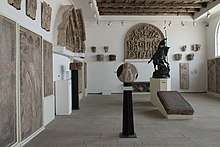
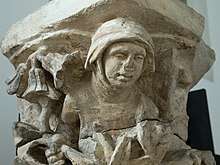
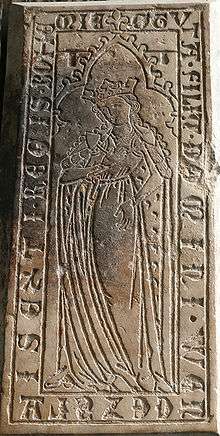
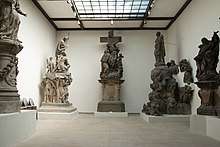
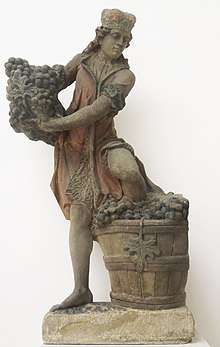
History
It has been located in a summer palace, projected for the city of Prague by architect Antonín Wiehl in 1891 for the National Land Jubilee exhibition on the new exhibition area Výstaviště in Prague 7 - Holešovice. It was opened only in 1905 for collections of Lapidarium. It houses valuable stone sculptures dating from the 11th to the early 20th century.[1] The museum has a collection of around 2000 artefacts, 420 of which are on permanent display in eight halls of approximative area of 1500 square meters.
1. Romanic and the early Gothic period
The oldest Romanic fragments from the crypt of St. Vitus basilica of the Prague Castle are dated to the late 11th century. Romanic stove tiles decorated with reliefs of lion, gryphon, sphinx or emperor Nero come from basilika on Prague-Vyšehrad. Eight tombstones with engraved figures of abbots as well as various architectonical fragments of 11th to 13th century originate from the Benedictine abbey Ostrov (Insula), founded in 999 on the river Vltava near Prague and destroyed in 15th century; nearly 900 fragments were gained fro m the archaeological excavations in 1932.
2. High and Late Gothic period
Six original gothic statues from the Charles Bridge Tower (Emperor Charles IV, his son King Wenceslas IV, patron saints Vitus, Adalbert of Prague, Sigismundus and a lion can be seen here among others.[2]
3. Rennaissance
The Krocin's water fountain cut of rose marble comes from Old Town square, it was moved here between 1911-1914. Several tombstones come from destroyed Prague cemeteries.
4. Hall of the Virgin Mary Pest Column
Fragments of Virgin Mary Immaculata among four archangels fighting with dragons, five statues of sandstone made by Johann Georg Bendl for the Old Town Square in Prague in 1650 after the idea of Emperor Ferdinand III (Maria Victoria) and destroyed by anarchists in 1918.
5. Hall of the Charles Bridge
Seven original baroque groups of statues include the largest monuments: Ecstase of sainte Ludgardis, made by Matthias Bernard Braun, St Francis Xaverius baptising Indians and The Apotheose of St Ignatius of Loyola by Ferdinand Maxmilian Brokoff, which fell into the river in 1890 and was never recovered.
6. Hall of the Bohemian high Baroque style
It houses the first statue of the Bohemian patron saint Wenceslas, made by Johann Georg Bendl in 1680 for the Horse Market (later Wenceslas Square). Another St Wenceslas statue shows the saint picking wine grapes for Holy mass. Six statues of saints comes from the facade of St Gallus Church two statues were made for Loretto Church in Prague - Hradčany.
7. Hall of the Rococo style and Historicism
Roccocco is represented before all by a set of allegorical statues from the garden of a summer palace America projected by Kilian Ignac Dienzenhofer. Statues made by Ignac Platzer originate from the Palais Kinsky in Prague. Models of statues show decoration of the historical building of the National Museum (round 1891).
8. Hall of Habsburg' Emperors
Monuments of the Austrian emperors: Equestrian statue of Francis I and standing figure of Franz Joseph I were cast from brass for public spaces, as well as the monument of field marshall Joseph V. Radetzky von Radeč. Many of these monuments came to the Lapidarium after the World War I, when reminders of the old Austro-Hungarian monarchy were removed from public space by the new republican authorities.
Busts of Franz Joseph I and his wife, Elisabeth (called Sisi) of white marble sculpted by Antonin Wagner in 1891 were moved after the general reconstruction back to the Pantheon of the National Museum (opened in September, 2019).
Awards
In 1995, the Lapidarium was named one of the ten most beautiful museum exhibitions in Europe.[3]
References
http://www.nm.cz/Hlavni-strana/Visit-Us/Lapidarium-Lapidary-Exhibition-of-Stone-Monuments.html%5B%5D
Literature
- Jiri FAJT - Lubomir SRSEN: The Lapidarium of the National Museum. Guide through the permanent exhibition. Prague 1993.
- Dana STEHLÍKOVÁ: Lapidarium. In: The Great Book on the National Museum. Prague 2017; ISBN 978-80-7036-476-5